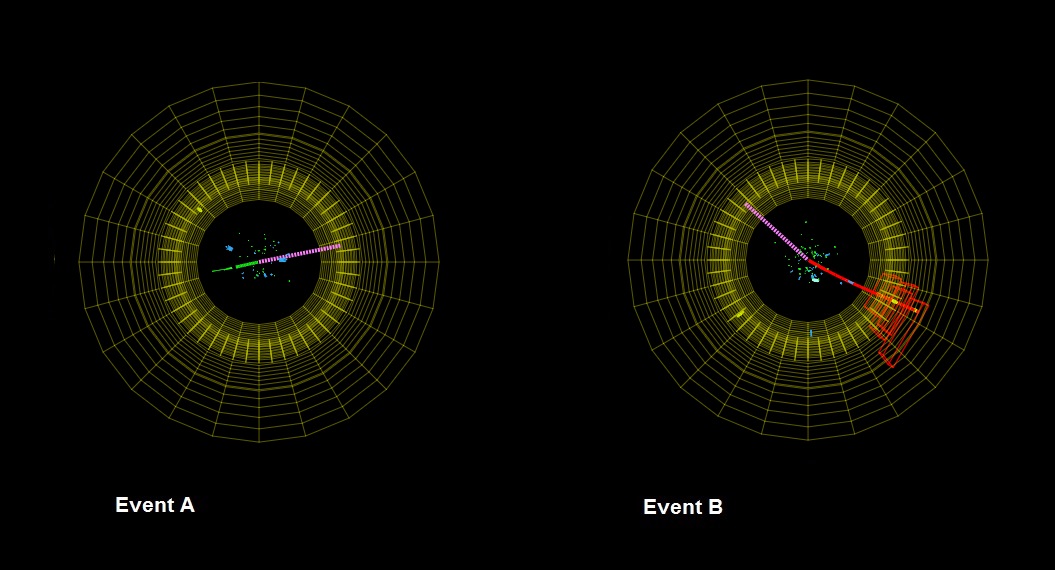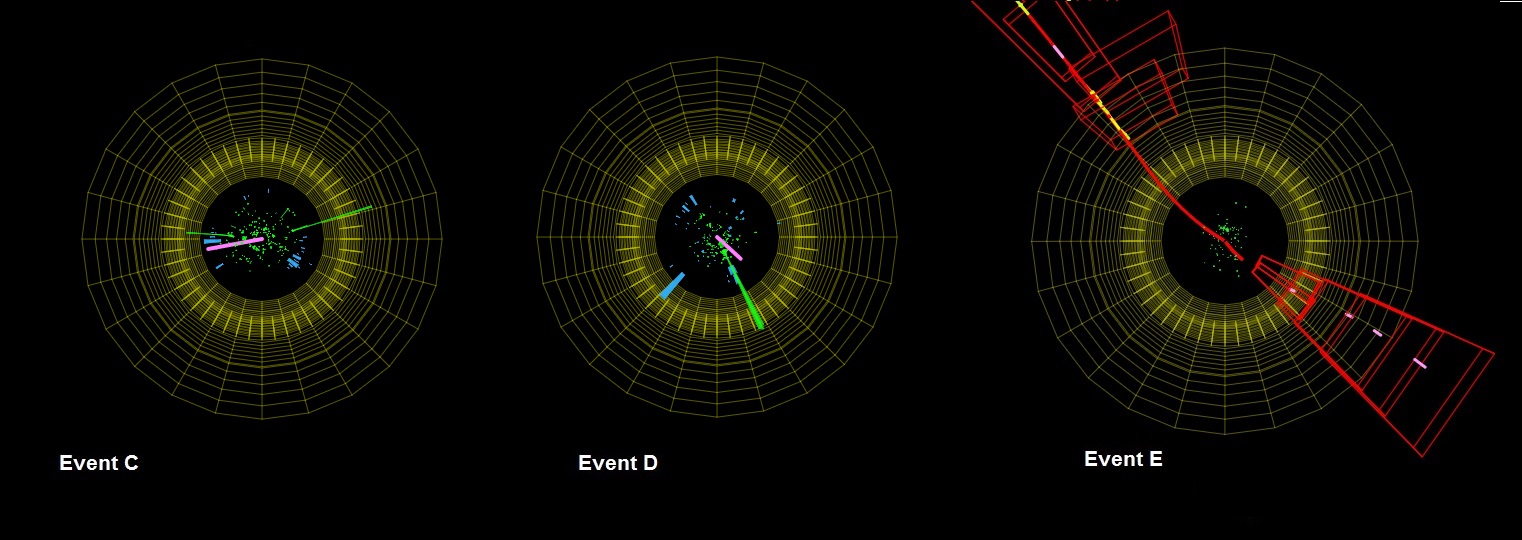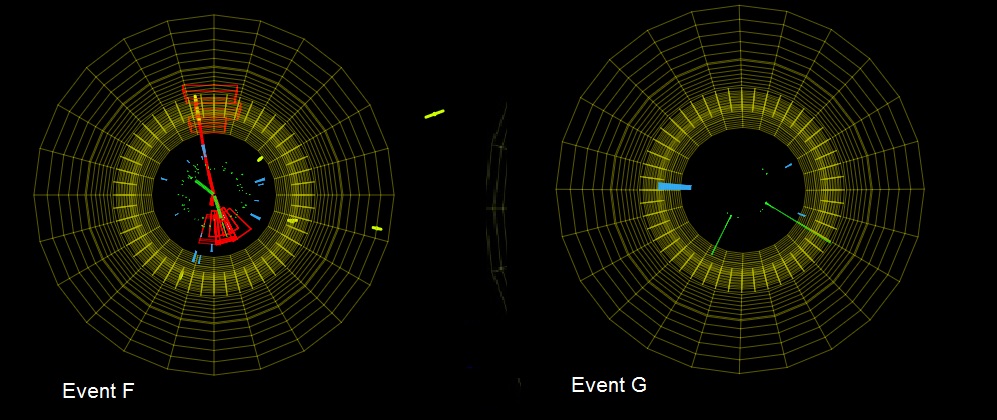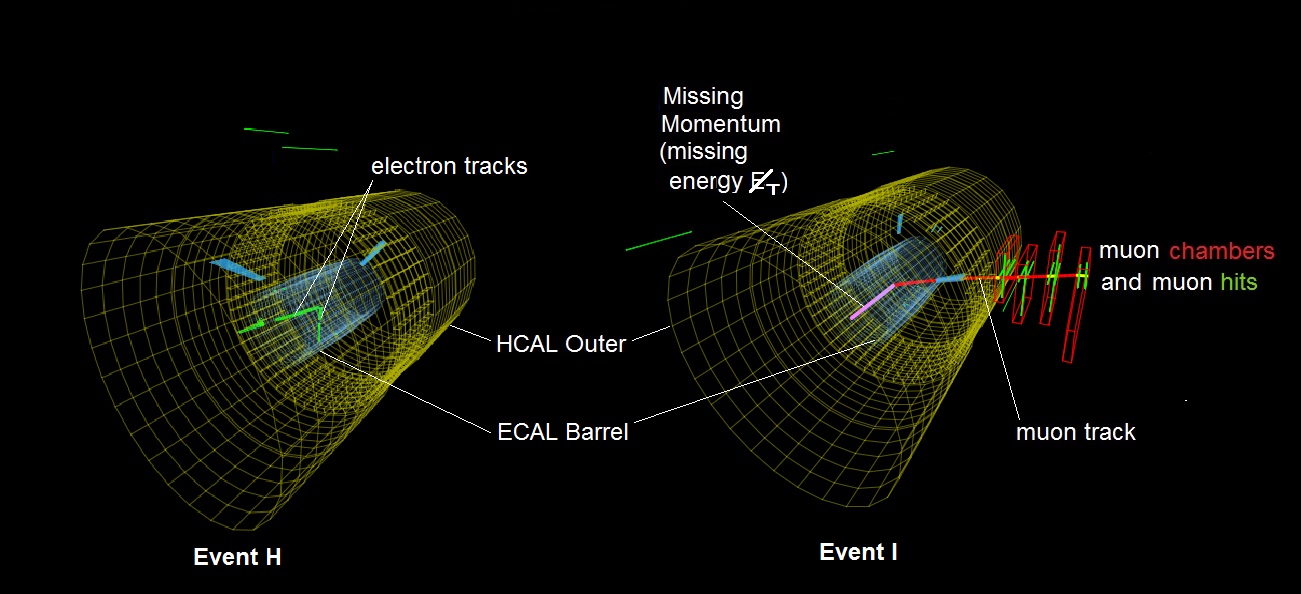You will study events with multiple signatures to:
- determine which are the best candidates for W, Z, Higgs bosons, and more.
- distinguish W+ from W- candidates,
- distinguish decays into electrons from decays into muons,
- determine key ratios,
- and build mass plots of dilepton and four-lepton events.
Background
When a W or a Z boson decays, it produces two particles called leptons. Electrons,
muons, and neutrinos are all leptons. So are their antiparticles.
Since the Z boson has zero charge, it can decay into two leptons of opposite charge (for
example, e+ and e-). W bosons have +1 or -1 charge, so a W can decay into a single electron
or muon plus a neutrino, which has no charge. This story goes deeper...but this is enough for now.

A Higgs boson has several possible decays. The one you are most likely to see is the Higgs boson decay into two Z bosons.
Single-lepton events (one lepton track plus missing momentum)
When a W+ or W- is produced in a proton-proton collision inside CMS, the W decays promptly. The two
leptons (electron or muon plus neutrino) leave from the point of decay out from the beamline and into
the detector itself. Electrons and muons are revealed as tracks in the inner detector. They curve in the
strong magnetic field in CMS: clockwise for positive charge or anticlockwise for negative, when seen in
an x-y view in the event display. Neutrinos are undetected; however, missing momentum in the system is
shown as a purple track and generally attributed to the neutrino.

|
Choose the image to the left to get a larger version for close inspection. Can you locate the "missing momentum"
vector in each of these events? Look closely at the curvature of the
"other" track in each. Which is most likely the decay of a W+? a W-? The short green track in Event A
indicates an electron. The longer red track in Event B which penetrates out
to the red boxes indicates a muon.
|
Dilepton events (two lepton tracks of the same kind)
When a Z boson is made in CMS, it too decays right away. Here, the two leptons are either a muon pair
(μ-μ+) or an electron pair (e-e+). No neutrino is produced,
so there should be no missing momentum. In practice, there is a lot going on in any one event and the
detector might miss something, so some missing momentum is possible.

|
Choose the image to the left to get a larger version for close inspection. Which of these is most likely to
be a Z decaying into muons? a Z to electrons? Which could be a W event? How can you distinguish a W candidate
from a Z candidate that might have some missing energy?
|
Four-lepton events (two dileptons from the same vertex)
There are several ways to obtain an event with four-leptons. We are concerned with two cases:
- A Higgs boson
decays to two Z bosons. The Z particles decay to leptons, as above, so we get four lepton
tracks: two muon pairs (2 x μ-μ+), two electron pairs
(2 x e-e+), or one muon and one electron pair
(μ-μ+e-e+).
- Other particle combinations which we might discover in our data.

|
Choose the image to the left to get a larger version for close inspection. Both of these events are Higgs
candidates. One of them shows two photons (two green energy towers from ECal with no corresponding tracks).
The other shows a possible Higgs decay into two Z bosons. Which do you think is which?
|
Elements of Events in iSpy-webgl

For each event, the beamline is along the common axis of the ECAL and HCAL wire-frame cylinders. Which is
the better W candidate? Is
the other dilepton, four-lepton, or something else? In each event, where do the collision and particle decay occur?
|
Before You Start
If you are not familiar with iSpy
and CIMA:
Analyze the Events
You will have the following to work with:
- Event Display:
- CMS Instrument for Masterclass Analysis:
- Partner
You and your partner examine the event display, interpret it, and use CIMA to record your observations. CIMA will help you find key ratios and histogram masses of particle candidates. Your mentor helps the whole group
understand the results before they are sent to the video conference moderators.

You and your partner will have 100 events to examine. When you observe an event, ask:
- Are the observable lepton tracks muons or electrons?
- Is this a 1-, 2-, or 4-lepton event? Or something else? Is it a "zoo" event?
- If it is single-lepton, is it W+ or W- candidate?
- If it is dilepton, can you identify the two lepton tracks and use them to find the invariant mass of
the parent particle?
- If it is more likely a four-lepton event, can you identify the four lepton tracks and use them to find the invariant mass of
a possible parent particle?
There will be places to record all of these in CIMA.
Results
Your mentor will help you combine the results from all students to get the following for the Masterclass Institute as a whole:
- the W/Z ratio (not as easy as it seems).
- the W+/W- ratio.
- the e/μ ratio.
- the mass of the Z and other particles with similar decays from the statistical combination in the dilepton mass plot.
- the masses of the parent particles from which the four-lepton events came and the possible identities of those particles.
Your CMS Masterclass Institute will combine with others in a video conference. The video conference activities are:
- Each Masterclass Institute will submit its results for discussion.
- The moderators will combine data from all Institutes and show a combined mass plot.
- A Q&A session in which you can ask questions about anything from how the LHC works to what a particle physicist does for fun.
|


